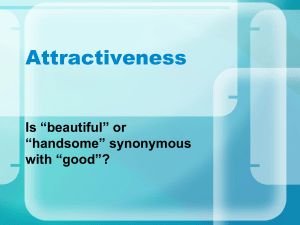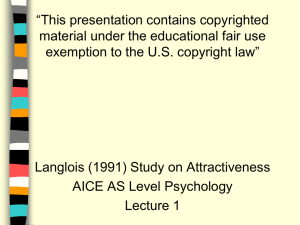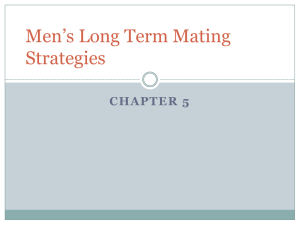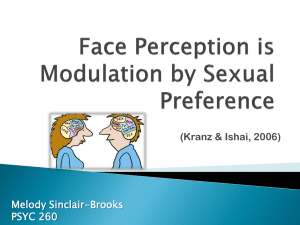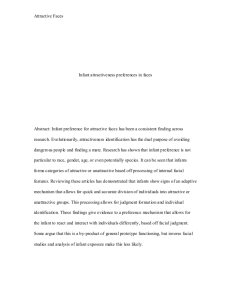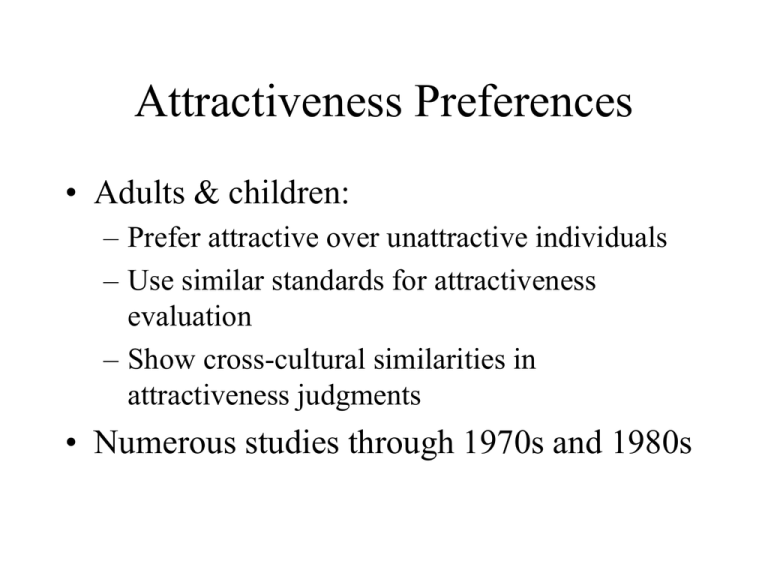
Attractiveness Preferences
• Adults & children:
– Prefer attractive over unattractive individuals
– Use similar standards for attractiveness
evaluation
– Show cross-cultural similarities in
attractiveness judgments
• Numerous studies through 1970s and 1980s
Historical Assumptions
• Gradual learning through exposure to
socialization agents (e.g., parents, peers)
and media
• Standards of attractiveness vary across
historic time, generations, and cultures
Origins of Attractiveness
Preferences
• Through extensive cultural input
• Learning processes (operant conditioning,
observational)
• Preferences shouldn’t become apparent until
age 3-5 years
• “Eye of the beholder” theory
• However, lack of empirical work
Empirical Methods
• Comparison of historical evidence (e.g.,
painting, sculpture, written descriptions, etc.)
• Cross cultural, longitudinal studies
• Look for attractiveness preferences in young
infants
Judith Langlois
• Developmental psychologist
• Social development, emphasis on origins of
social stereotypes, particularly facial
attractiveness
• Currently at University of Texas, Austin
Why Start with Facial
Attractiveness?
• Infant visual system
• Part of body most seen from early in life
• In humans, primary means of individual
identification
• Facial expressions
Infants Learn about Faces Early
• Infants prefer mother’s face to female
stranger within 45 hours of birth (Field et al.
1984)
• 12 to 36 hour old infants suck more to see
video of their mothers’ faces as opposed to
female stranger’s (Walton et al. 1992)
Development
• 3 months
– Discriminate familiar from unfamiliar faces
• 6 months
– Distinguish faces by age and sex
– Preferences for happy over angry faces
Gaze Time
• Show two paired side-by-side images
• Record amount of time gazing at each
image
• More time assumed to indicate greater
preference
Controls
• Differences between faces other than
attractiveness
– E.g., hair colour, skin colour, hair style, age
effects, sex, facial expression, etc.
• Can be quite challenging
Langlois et al. (1987)
• Undergraduates rated colour slides of adult
Caucasian women
• Selected 8 attractive and 8 unattractive
faces
• Paired images for gaze time testing
• Within-trial (attractive paired with
unattractive)
• Across-trial (two similarly ranked faces)
Results
• 34 six to eight month old infants
– 71% gazed longer at attractive faces
– 62% spent less time looking at paired
unattractive than paired attractive faces
• 30 two-three month old infants
– 63% gazed longer at attractive faces
– No significant differences for across-trial test
– Attentional processes? Focus on whatever seen
first?
Langlois et al. (1991)
• Faces rated for attractiveness by
undergraduates
• Adult Caucasian males, adult AfricanAmerican females, infant faces
• Six month old infants
• Infants prefer to look at attractive over
unattractive faces
Conclusions
• Infant preferences established at very early
age
• Gender, ethnicity, age not relevant to
preferences
• Too young for socialization model to
explain
• Preferences too diverse for socialization
model to explain
What is Beautiful is Good
• Attractive people possess positive attributes
(e.g., kindness, socially outgoing, etc.)
• Unattractive people possess negative traits
(e.g., mean, stupid, unpleasant, etc.)
• Transferring from perceptual to behavioural
• Common in adults (e.g., Dion, 1973)
• What about infants?
Langlois et al. (1990)
• Test that gaze time equates to beauty is
good in adults
• Used 12 month olds
• Infants interacted with female adult stranger
in attractive or unattractive lifelike latex
mask
• Stranger followed “scripted behaviours”;
rated as identical by observers for both
conditions
Results
• Strong social preference for “attractive” stranger
• More positive affect towards “attractive” stranger
• Similar findings where 12 month olds given two
dolls to play with; one with attractive, one with
unattractive head
• Infants’ visual preferences for attractive faces
functionally equivalent to social preferences for
attractiveness in adults and older children
What Makes a Face Attractive?
• Langlois suggests averageness
• Galton (1878) photo-averaged faces of criminals;
inadvertently found regression toward the mean
• Langlois & Roggman (1990)
– Morphed up to 32 faces; 16 & 32 morphs most
attractive
• Langlois lab
By “Average” We Mean…
• Average faces not average in attractiveness
• Average in terms of the mean, or central,
tendency of facial traits of the population
• Average faces are above average in
attractiveness, in terms of how much
infants, children, and adults like them, and
in terms of how much people consider them
good examples of a face
An Adaptationist Explanation
• Individuals showing population averages of
traits likely free from aversive genetic
conditions (e.g., mutations, deleterious
recessives, etc.)
• Selection favours mate choice of individuals
with average morphological traits
Infant and Child Facial
Appearance
• Affects adult interactions and behaviour
• Unrelated adult females punished
unattractive children more than attractive
children
• Berkowitz & Frodi (1979), Dion (1972,
1974)
Child Physical Abnormalities
• Mothers treat these children differently
• Congenital facial anomalies; mothers less
verbal and more controlling (Allen, et al. 1990)
• Cleft lip; mothers smiled at, spoke less, and
imitated less (Field & Vega-Lahr 1984)
• Overall, less parental care for these children
Langlois, et al. (1995)
• What about attractiveness in normal
populations of children?
• Infant attractiveness and maternal attitudes
and behaviours
• 173 mothers and their infants
• Three ethnic groups (white, African
American, Mexican American)
Method
• Observers coded frequency and duration of
63 maternal and 50 infant behaviours at
newborn and 3 months
• Questionnaire assessing parenting attitudes
and knowledge
• Colour photos of infants’ faces and mothers’
faces rated for attractiveness by adults
Findings
• Mothers of attractive newborns more
affectionate, showed greater caregiving, and
more attention to their infants
• Mothers of unattractive newborns more
likely to say their infants interfered with
their lives, but did not express attitudes of
rejection to their infants
• Maternal attractiveness had no effect on
results
Infant Phenotype and Health
• Low body weight (LBW)
• Health risks
– Infant and child health problems: morbidity,
physical, neurological, behavioural deficiencies
(Sweet et al. 2003)
• Parental care
– Less affection, attention, general care (Mann
1992)
Volk et al. (2005)
• Do infant facial cues indicating LBW
influence adults’ perceptions of infants and
desire to give parental care?
• Hypothetical adoption paradigm
• Adults shown
– Unaltered faces of infants and children
– Faces digitally manipulated to simulate LBW
• Rate faces for cuteness, health, preference
for adoption
Stimuli
• Five children’s faces
– 18 months and 48 months
– Normal
– Morphed to represent 10% reduction in body
weight
Findings
• Normal faces rated as significantly cuter,
healthier, and more likely to be adopted
• Adult women gave significantly higher
ratings on all measures than men
EP Implications
• Assessments of health and fitness made for
infant and child faces
• Positive correlation between facial
attractiveness and health issues
Investment
• Gestation expensive
• Childrearing even more so
• Reluctance to expend energy on low-viable
offspring
• Differential reproductive success and selfish
gene theory
• Put energy into best offspring
Female/Male Differences
• Reproductive and rearing costs higher for
females
• Volk, et al. (2005) supports this
– Females need to be more selective

